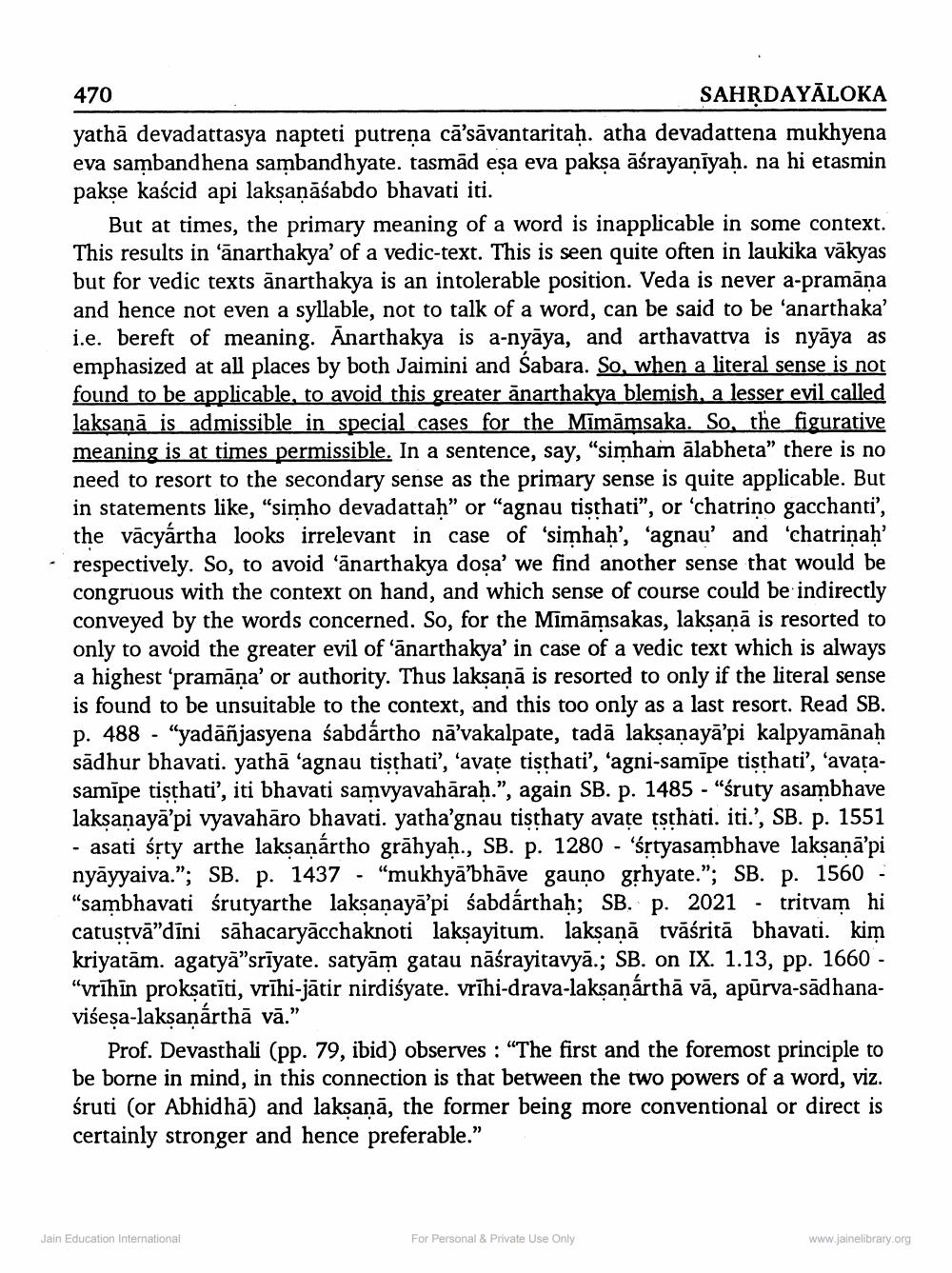________________
470
SAHRDAYĀLOKA yathā devadattasya napteti putreņa cā’sāvantaritaḥ. atha devadattena mukhyena eva sambandhena sambandhyate, tasmād esa eva paksa āśrayaniyah. na hi etasmin pakṣe kaścid api laksaņāśabdo bhavati iti.
But at times, the primary meaning of a word is inapplicable in some context. This results in 'ānarthakya' of a vedic-text. This is seen quite often in laukika vākyas but for vedic texts ānarthakya is an intolerable position. Veda is never a-pramāna and hence not even a syllable, not to talk of a word, can be said to be 'anarthaka' i.e. bereft of meaning. Anarthakya is a-nyāya, and arthavattva is nyāya as emphasized at all places by both Jaimini and Sabara. So, when a literal sense is not found to be applicable, to avoid this greater anarthakya blemish, a lesser evil called laksanā is admissible in special cases for the Mimāmsaka. So, the figurative meaning is at times permissible. In a sentence, say, "simham alabheta" there is no need to resort to the secondary sense as the primary sense is quite applicable. But in statements like, “simho devadattah" or "agnau tisthati”, or 'chatrino gacchanti', the vācyártha looks irrelevant in case of 'simhah', 'agnau' and 'chatrinah respectively. So, to avoid 'anarthakya dosa' we find another sense that would be congruous with the context on hand, and which sense of course could be indirectly conveyed by the words concerned. So, for the Mimāmsakas, laksaņā is resorted to only to avoid the greater evil of 'ānarthakya' in case of a vedic text which is always a highest 'pramāna' or authority. Thus laksaņā is resorted to only if the literal sense is found to be unsuitable to the context, and this too only as a last resort. Read SB. p. 488 - "yadāñjasyena śabdártho nā'vakalpate, tadā laksanayā’pi kalpyamanah sādhur bhavati. yathā ‘agnau tisthati', 'avate tisthati', 'agni-samīpe tisthati', 'avațasamīpe tişthati', iti bhavati samvyavahāraḥ.”, again SB. p. 1485 - "śruty asambhave laksanayā’pi vyavahāro bhavati. yatha’gnau tişthaty avațe tsthati. iti.', SB. p. 1551 - asati śșty arthe laksanártho grāhyah., SB. p. 1280 - 'śrtyasambhave laksanā’pi nyāyyaiva."; SB. p. 1437 - “mukhyā'bhāve gauņo gļhyate."; SB. p. 1560 - "sambhavati śrutyarthe laksanayā’pi śabdárthaḥ; SB. p. 2021 · tritvam hi catustvā”dīni sāhacaryācchaknoti laksayitum. laksaņā tvāśritā bhavati. kim kriyatām. agatyā"srīyate. satyām gatau nāśrayitavyā.; SB. on IX. 1.13, pp. 1660 - "vrihīn prokşatīti, vrīhi-jātir nirdiśyate. vrīhi-drava-laksanárthā vā, apūrva-sādhanaviśesa-laksanárthā vā."
Prof. Devasthali (pp. 79, ibid) observes : "The first and the foremost principle to be borne in mind, in this connection is that between the two powers of a word, viz. śruti (or Abhidha) and laksanā, the former being more conventional or direct is certainly stronger and hence preferable."
Jain Education International
For Personal & Private Use Only
www.jainelibrary.org




